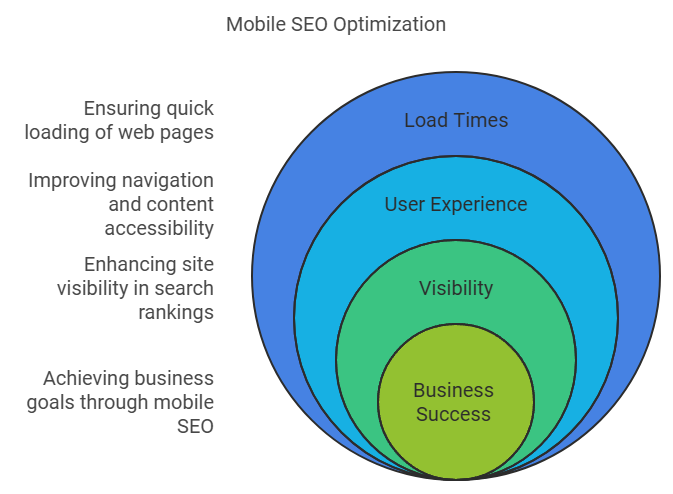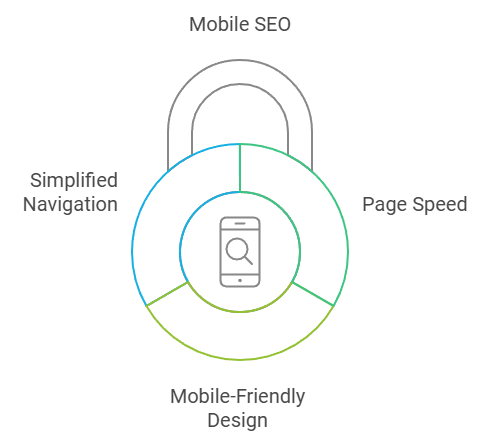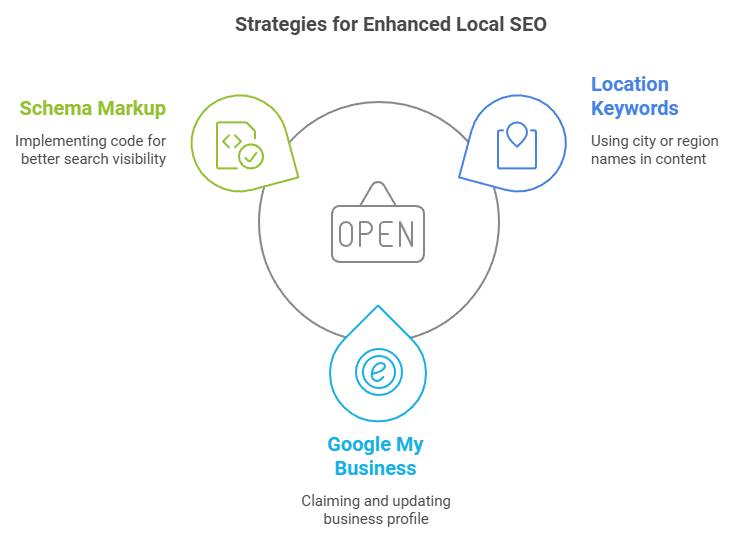Let us dive into what makes Mobile SEO so important and how you can improve your website to meet mobile users’ needs.
Table of Contents
ToggleWhat is Mobile SEO and Why Does It Matter?
Mobile SEO refers to the process of optimizing your website so it performs well on mobile devices. With most internet users browsing through smartphones, a website that loads quickly, looks good, and works smoothly on mobile screens can significantly impact your business’s success.
Mobile SEO is not just about shrinking content to fit a smaller screen. It involves:
- Ensuring quick load times.
- Simplifying navigation.
- Making text and visuals easy to view.
Why it matters: Google ranks websites based on how well they perform on mobile devices. If your site is not mobile-optimized, it could drop in rankings, reducing your visibility.
How to Check If Your Website is Mobile-Friendly

Before improving Mobile SEO, you need to know how your website performs. Here are some easy ways to check:
1. Use Google’s Mobile-Friendly Test
Google offers a free tool to analyze your site’s mobile usability. Simply enter your URL, and you will receive a report detailing any problems.
2. Browse Your Website on Different Devices
View your website on multiple smartphones and tablets to identify design or navigation issues.
3. Monitor Mobile Analytics
Your website’s analytics platform can show how mobile users interact with your site. Look for bounce rates and average session durations.
Key Mobile SEO Factors You Should Focus On
Optimizing your website for mobile involves addressing specific aspects. Let us break them down step by step.

1. Page Speed
Mobile users expect quick results. If your site takes too long to load, visitors might leave before it fully opens.
How to improve speed:
- Compress images.
- Minimize code and scripts.
- Enable browser caching.
2. Mobile-Friendly Design
A responsive design ensures your website adjusts automatically to different screen sizes. This approach eliminates the need for separate mobile and desktop versions.
What to look for:
- Fonts should be readable without zooming.
- Buttons and links should be easy to tap.
- Content should not overflow or require horizontal scrolling.
3. Simplified Navigation
Mobile users appreciate straightforward menus and search functions.
Tips for better navigation:
- Use a hamburger menu for compactness.
- Keep the menu options minimal and clear.
- Include a search bar at the top of your pages.
The Role of Content in Mobile SEO
Quality content is at the heart of Mobile SEO. However, how your content appears on mobile screens is equally important.
1. Short Paragraphs
Mobile screens display limited text at a time. Write in short blocks to make reading easier.
2. Clear Headings
Use descriptive headings to guide users through your content. This also helps search engines understand your website better.
3. Visual Elements
Images and videos make your content engaging but should not slow down your page. Use compressed formats and avoid autoplay features.
Technical Improvements for Mobile SEO
1. Use Accelerated Mobile Pages (AMP)
AMP is a framework designed to make pages load faster on mobile devices. It simplifies your site’s code, leading to quicker performance.
2. Avoid Pop-Ups
Pop-ups can frustrate mobile users and interrupt their experience. Google may penalize sites with intrusive interstitials.
3. Optimize Meta Tags for Mobile Users
Ensure your meta titles and descriptions are concise yet informative. Mobile screens display fewer characters, so prioritize your focus keyphrase like “Mobile SEO.”
The Impact of Local SEO on Mobile Traffic
Many mobile users are searching for local services. Combining Mobile SEO with Local SEO can drive foot traffic to your business.

1. Add Location Keywords
Include your city or region in your content, meta tags, and headings.
2. Claim Your Google Business Profile
Having an updated profile increases your chances of appearing in local searches.
3. Use Schema Markup
This code helps search engines understand your content better and display relevant information, such as your business address and contact details.
How Voice Search Influences Mobile SEO
With the rise of virtual assistants like Siri and Google Assistant, voice search has become a key component of Mobile SEO.
Adapting to Voice Search
- Use natural language in your content.
- Answer common questions your audience might ask.
- Focus on long-tail keywords.
Monitoring and Maintaining Your Mobile SEO
Improving Mobile SEO is not a one-time effort. Regular monitoring is essential to keep up with changes in technology and user behavior.
Tools You Can Use
- Google Analytics: To track user behavior.
- Google Search Console: To identify and fix technical issues.
- PageSpeed Insights: For detailed performance reports.
Common Mistakes to Avoid in Mobile SEO

1. Ignoring Mobile Usability
Do not assume a desktop design will work perfectly on mobile. Test frequently.
2. Oversized Media Files
Large images and videos can drastically slow down your site.
3. Skipping Mobile-First Indexing
Google prioritizes mobile-friendly websites. Ignoring this could hurt your rankings.
Steps to Get Started with Mobile SEO Today
If you are unsure where to begin, follow these simple steps:
- Test your website’s mobile usability.
- Address loading speed issues.
- Simplify your design for smaller screens.
- Regularly update and monitor your progress.
By focusing on Mobile SEO, your business website can reach a wider audience, improve user satisfaction, and grow your online presence effectively.
Conclusion
Mobile SEO is an essential part of running a successful business website. By ensuring your site is fast, user-friendly, and optimized for mobile visitors, you can improve visibility, attract more customers, and achieve better results. Remember, a little effort today can have a lasting impact on your online presence.
FAQs
1. What is Mobile SEO?
Mobile SEO is the process of optimizing a website to ensure it performs well on mobile devices, offering a smooth user experience.
2. How does Mobile SEO affect rankings?
Google prioritizes mobile-friendly sites in its rankings. Without Mobile SEO, your website may struggle to rank highly.
3. What tools help with Mobile SEO?
Tools like Google Analytics, Google Search Console, and Page Speed Insights can assist in identifying and fixing mobile-related issues.
4. Why is responsive design important?
Responsive design ensures your website looks and functions well on all screen sizes without requiring a separate mobile version.
5. Can Mobile SEO help local businesses?
Yes, combining Mobile SEO with Local SEO can improve local visibility and drive traffic to brick-and-mortar stores.









[…] messaging should drive results. Also, look for increases in website conversions, email sign-ups, or product […]